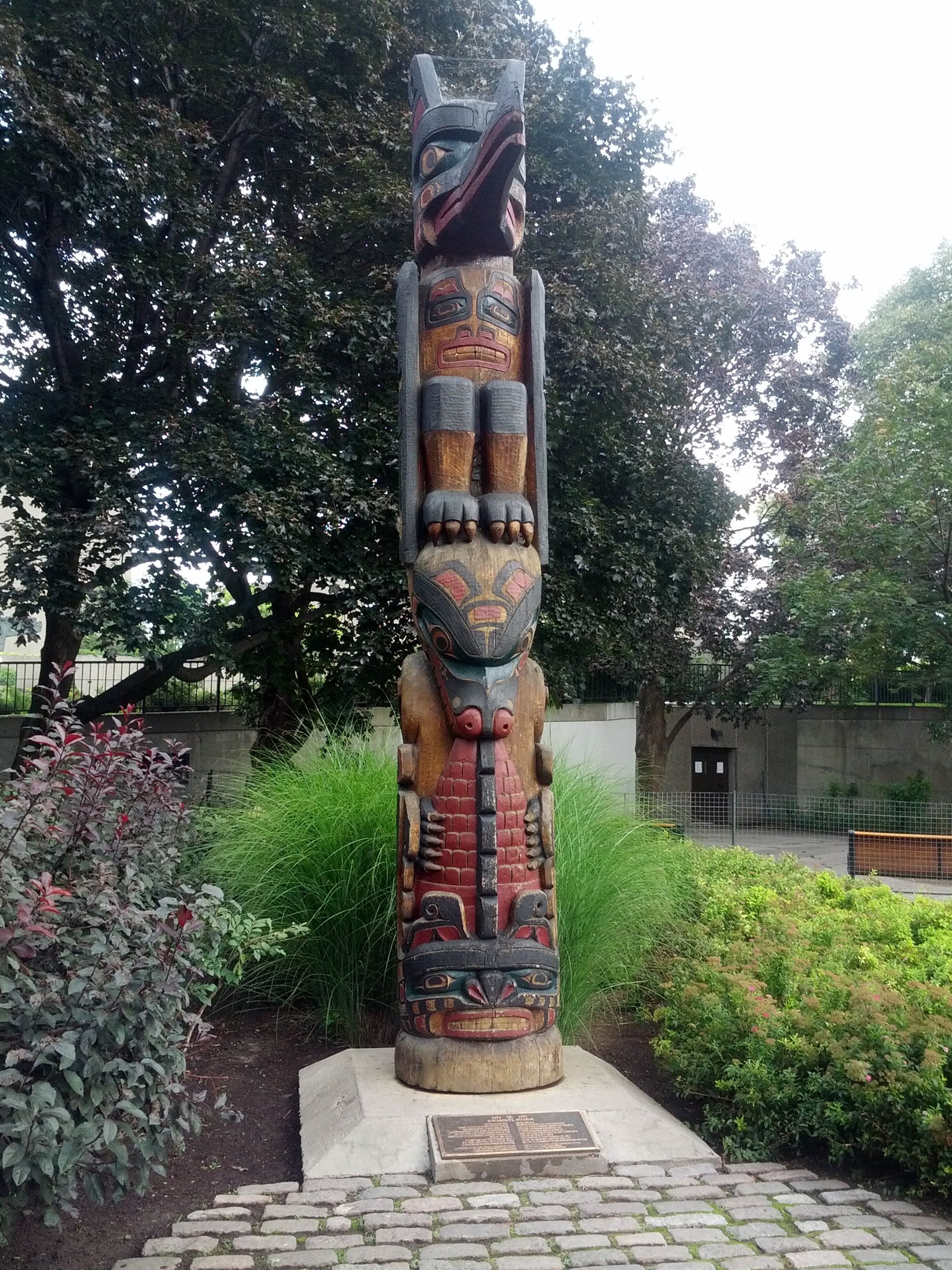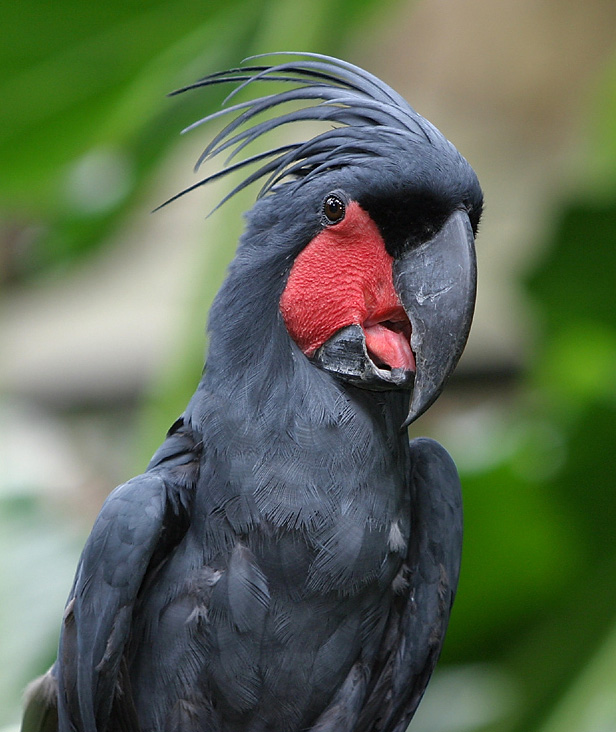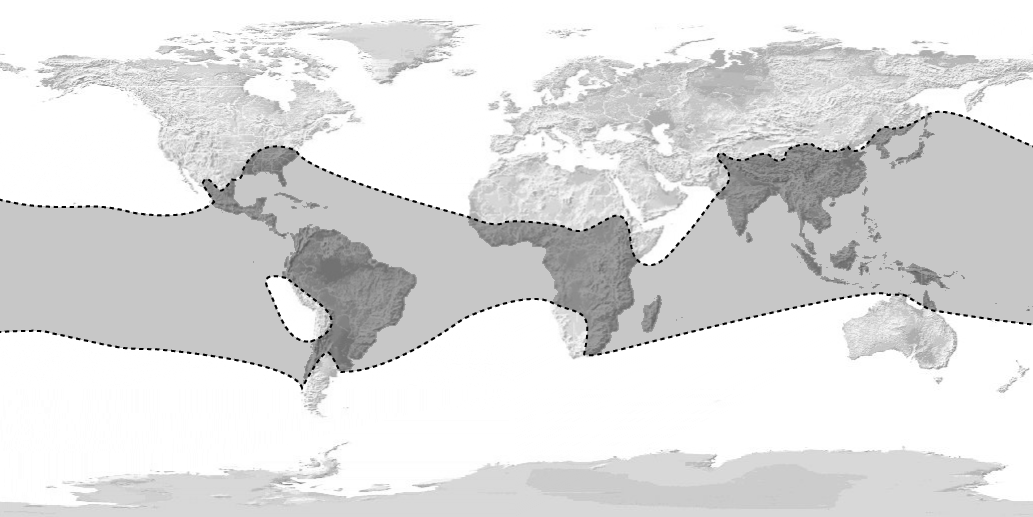|
Bilibil
Prior to 1904, the Bilibil people lived on an island offshore from Madang, Papua New Guinea, trading clay pots along the coast from Karkar Island to western Morobe Province. The island was too small to produce enough food for the inhabitants, and the trade therefore was an essential element of their life. They moved to the mainland to their existing village site to improve their subsistence levels. They speak the Bilibil language, an Austronesian language. Pot making Bilibil women make pots, which are still produced in the traditional way. Clay for the pots is collected locally, and mixed with sand and water. The pots are hollowed out with stones and smoothed on the outside by beating with a flat board. Before they are fired, red clay is painted on the pots. This turns them a glossy red and black when they are pulled out of the fire. The pots are put to many uses; most importantly, they are used for bride price ceremonies. Sometimes pots are still bartered for food. Inland pe ... [...More Info...] [...Related Items...] OR: [Wikipedia] [Google] [Baidu] |
Bilibil Language
Bil Bil is an Austronesian language spoken by about 1,200 people near Madang town, Madang Province, Papua New Guinea Papua New Guinea, officially the Independent State of Papua New Guinea, is an island country in Oceania that comprises the eastern half of the island of New Guinea and offshore islands in Melanesia, a region of the southwestern Pacific Ocean n .... References Languages of Madang Province Bel languages {{NNGuinea-lang-stub ... [...More Info...] [...Related Items...] OR: [Wikipedia] [Google] [Baidu] |
Madang
Madang (old German name: ''Friedrich-Wilhelmshafen'') is the capital of Madang Province and is a town with a population of 27,420 (in 2005) on the north coast of Papua New Guinea. History Nicholai Miklukho-Maklai was probably the first European to visit the area. In 1871 he stayed at Astrolabe Bay south of present-day Madang for 15 months. He had a good relationship with the local communities before leaving, suffering from malaria. In April 1884 an expedition by the German New Guinea Company led by Otto Finsch and Eduard Dallmann arrived and named the landing point "Friedrich Wilhelmshafen"; however, they felt that the area was unsuitable for a settlement. A subsequent survey in 1888 mentioned good soil conditions that would make a coffee plantation possible. In the summer of 1891 a station was built and by September 1892 was the seat of the provincial administration; however, the Imperial Government Commissioner remained at Stephansort, some 23 kilometers away due to conc ... [...More Info...] [...Related Items...] OR: [Wikipedia] [Google] [Baidu] |
Island
An island or isle is a piece of land, distinct from a continent, completely surrounded by water. There are continental islands, which were formed by being split from a continent by plate tectonics, and oceanic islands, which have never been part of a continent. Oceanic islands can be formed from volcano, volcanic activity, grow into atolls from coral reefs, and form from sediment along shorelines, creating barrier islands. River islands can also form from sediment and debris in rivers. Artificial islands are those made by humans, including small rocky outcroppings built out of lagoons and large-scale land reclamation projects used for development. Islands are host to diverse plant and animal life. Oceanic islands have the sea as a natural barrier to the introduction of new species, causing the species that do reach the island to evolve in isolation. Continental islands share animal and plant life with the continent they split from. Depending on how long ago the continental is ... [...More Info...] [...Related Items...] OR: [Wikipedia] [Google] [Baidu] |
Yam (vegetable)
Yam is the common name for some plant species in the genus ''Dioscorea'' (family Dioscoreaceae) that form edible tubers (some other species in the genus being toxic). Yams are perennial herbaceous vines native to Africa, Asia, and the Americas and cultivated for the consumption of their starchy tubers in many temperate climate, temperate and tropics, tropical regions. The tubers themselves, also called "yams", come in a variety of forms owing to numerous cultivars and related species. Description A Monocotyledon, monocot related to lilies and grasses, yams are vigorous herbaceous, perennial plant, perennially growing vines from a tuber. Some 870 species of yams are known, a few of which are widely grown for their edible tuber but others of which are toxic (such as ''Dioscorea communis, D. communis''). Yam plants can grow up to in length and high. The tuber may grow into the soil up to deep. The plant disperses by seed. The edible tuber has a rough skin that is diffi ... [...More Info...] [...Related Items...] OR: [Wikipedia] [Google] [Baidu] |
Pleiades
The Pleiades (), also known as Seven Sisters and Messier 45 (M45), is an Asterism (astronomy), asterism of an open cluster, open star cluster containing young Stellar classification#Class B, B-type stars in the northwest of the constellation Taurus (constellation), Taurus. At a distance of about 444 light-years, it is among the nearest star clusters to Earth and the nearest Messier object to Earth, being the most obvious star cluster to the naked eye in the night sky. It is also observed to house the reflection nebula NGC 1432, an HII region. Around 2330 BC it marked the vernal point. Due to the brightness of its stars, the Pleiades is viewable from most areas on Earth, even in locations with significant light pollution. The cluster is dominated by OB star, hot blue luminous stars that have formed within the last 100 million years. Reflection nebulae around the brightest stars were once thought to be leftover material from their formation, but are now considered likely to be an u ... [...More Info...] [...Related Items...] OR: [Wikipedia] [Google] [Baidu] |
Meal
A meal is an occasion that takes place at a certain time and includes consumption of food. The English names used for specific meals vary, depending on the speaker's culture, the time of day, or the size of the meal. A meal is different from a snack in that meals are generally larger, more varied, and more filling. Though they can be eaten anywhere, meals usually take place in homes, restaurants, and cafeterias. Regular meals occur on a daily basis, typically several times a day. Special meals are normally held in conjunction with celebratory or momentous occasions such as birthdays, weddings, anniversaries, funerals, and holidays. The type of food that is served or consumed at any given time depends on regional customs. Three main meals are typically eaten in the morning, early afternoon, and evening in most civilizations. Furthermore, the names of meals are often interchangeable by custom as well. Some serve dinner as the main meal at midday, with supper as the late aftern ... [...More Info...] [...Related Items...] OR: [Wikipedia] [Google] [Baidu] |
Yam (vegetable)
Yam is the common name for some plant species in the genus ''Dioscorea'' (family Dioscoreaceae) that form edible tubers (some other species in the genus being toxic). Yams are perennial herbaceous vines native to Africa, Asia, and the Americas and cultivated for the consumption of their starchy tubers in many temperate climate, temperate and tropics, tropical regions. The tubers themselves, also called "yams", come in a variety of forms owing to numerous cultivars and related species. Description A Monocotyledon, monocot related to lilies and grasses, yams are vigorous herbaceous, perennial plant, perennially growing vines from a tuber. Some 870 species of yams are known, a few of which are widely grown for their edible tuber but others of which are toxic (such as ''Dioscorea communis, D. communis''). Yam plants can grow up to in length and high. The tuber may grow into the soil up to deep. The plant disperses by seed. The edible tuber has a rough skin that is diffi ... [...More Info...] [...Related Items...] OR: [Wikipedia] [Google] [Baidu] |
Verandah
A veranda (also spelled verandah in Australian and New Zealand English) is a roofed, open-air hallway or porch, attached to the outside of a building. A veranda is often partly enclosed by a railing and frequently extends across the front and sides of the structure. Although the form ''verandah'' is correct and very common, some authorities prefer the version without an "h" (the ''Concise Oxford English Dictionary'' gives the "h" version as a variant and '' The Guardian Style Guide'' says "veranda not verandah"). Australia's ''Macquarie Dictionary'' prefers ''verandah''. Etymology ''Veranda'', as used in the United Kingdom and France, was brought by the British from India (, ). While the exact origin of the word is unknown, scholars suggest that the word may have originated in India or may have been adopted from the Portuguese and spread further to the British and French colonists. Ancient and medieval Indian texts on domestic architecture like Vastu shastra uses the word ... [...More Info...] [...Related Items...] OR: [Wikipedia] [Google] [Baidu] |
Totem
A totem (from or ''doodem'') is a spirit being, sacred object, or symbol that serves as an emblem of a group of people, such as a family, clan, lineage (anthropology), lineage, or tribe, such as in the Anishinaabe clan system. While the word ''totem'' itself is an anglicisation of the Ojibwe term (and both the word and beliefs associated with it are part of the Ojibwe language and Ojibwe, culture), belief in Tutelary deity, tutelary spirits and deities is not limited to the Ojibwe people. Similar concepts, under differing names and with variations in beliefs and practices, may be found in a number of cultures worldwide. The term has also been adopted, and at times redefined, by anthropologists and philosophers of different cultures. Contemporary Neoshamanism, neoshamanic, New Age, and mythopoetic men's movements not otherwise involved in the practice of a traditional, tribal religion have been known to use "totem" terminology for the personal identification with a tutelary sp ... [...More Info...] [...Related Items...] OR: [Wikipedia] [Google] [Baidu] |
Cockatoo
A cockatoo is any of the 21 species of parrots belonging to the family Cacatuidae, the only family in the superfamily Cacatuoidea. Along with the Psittacoidea ( true parrots) and the Strigopoidea (large New Zealand parrots), they make up the order Psittaciformes. The family has a mainly Australasian distribution, ranging from the Philippines and the eastern Indonesian islands of Wallacea to New Guinea, the Solomon Islands and Australia. Cockatoos are recognisable by their prominent crests and curved bills. Their plumage is generally less colourful than that of other parrots, being mainly white, grey, or black and often with coloured features in the crest, cheeks, or tail. On average, they are larger than other parrots; however, the cockatiel, the smallest cockatoo species, is medium-sized. The phylogenetic position of the cockatiel remains unresolved, except that it is one of the earliest offshoots of the cockatoo lineage. The remaining species are in two main clades. ... [...More Info...] [...Related Items...] OR: [Wikipedia] [Google] [Baidu] |
Bamboo
Bamboos are a diverse group of mostly evergreen perennial plant, perennial flowering plants making up the subfamily (biology), subfamily Bambusoideae of the grass family Poaceae. Giant bamboos are the largest members of the grass family, in the case of ''Dendrocalamus sinicus'' having individual stalks (Culm (botany), culms) reaching a length of , up to in thickness and a weight of up to . The internodes of bamboos can also be of great length. ''Kinabaluchloa, Kinabaluchloa wrayi'' has internodes up to in length. and ''Arthrostylidium schomburgkii'' has internodes up to in length, exceeded in length only by Cyperus papyrus, papyrus. By contrast, the stalks of the tiny bamboo Raddiella, ''Raddiella vanessiae'' of the savannas of French Guiana measure only in length by about in width. The origin of the word "bamboo" is uncertain, but it most likely comes from the Dutch language, Dutch or Portuguese language, Portuguese language, which originally borrowed it from Malay langua ... [...More Info...] [...Related Items...] OR: [Wikipedia] [Google] [Baidu] |
Pandanus
''Pandanus'' is a genus of monocots with about 578 accepted species. They are palm-like, dioecious trees and shrubs native to the Old World tropics and subtropics. Common names include pandan, screw palm and screw pine. The genus is classified in the order Pandanales, family Pandanaceae, and is the largest in the family. Description The species vary in size from small shrubs less than tall, to medium-sized trees tall, typically with a broad canopy, heavy fruit, and moderate growth rate. The trunk is stout, wide-branching, and ringed with many leaf scars. Mature plants can have branches. Depending on the species, the trunk can be smooth, rough, or warty. The roots form a pyramidal tract to hold the trunk. They commonly have many thick stilt roots near the base, which provide support as the tree grows top-heavy with leaves, fruit, and branches. These roots are adventitious and often branched. The top of the plant has one or more crowns of strap-shaped leaves that may be s ... [...More Info...] [...Related Items...] OR: [Wikipedia] [Google] [Baidu] |









